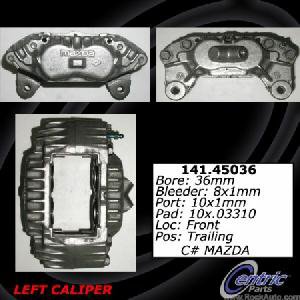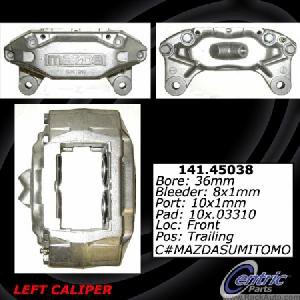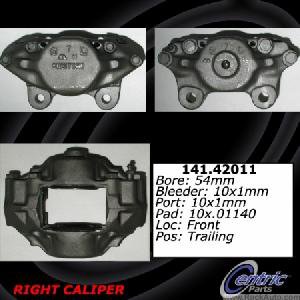
BrakePower
Members-
Posts
7 -
Joined
-
Last visited
Contact Methods
-
Website URL
http://www.brakepower.com
Profile Information
-
Gender
Not Telling
-
Location
Texas
BrakePower's Achievements
Newbie (1/14)
0
Reputation
-
has anyone installed Rx7 brakes?
BrakePower replied to andyhorror's topic in Brakes, Wheels, Suspension and Chassis
I noticed that regarding caliper piston size, the numbers are not always accurate... Usually, when I need information about piston diameters, I go to RockAuto.com that has pictures and measurements posted on most parts they sell. For example: the 4 pistons of the RX7 caliper have a 36mm diameter and the 240Z has two 54mm pistons. See attached pictures of the RX7 FC, RX7 FD and 240Z calipers. With the Total Piston Area Calculator we quickly find that the RX7 has 8138.88mm² and the 240Z 9156.24mm² on the front axle. This information tells us that we would lose 11% total piston area, and therefore clamping force would go down 11% as well. If the rear brakes were not participating enough and pedal effort was light to begin with, this could be a very good swap. On the other hand, if pedal effort was high already, and the rear axle was over-braked or perfectly balanced with the front, the swap would require a serious look at (and possibly redesign of) the rest of the system, in order to make it work right. For example a slightly smaller M/C (to compensate for the reduction in Total Piston Area up front) and adjustable proportioning valve (to reduce hydraulic pressure increase (with increasing pedal pressure) to the rear brakes). Or even a larger rotor and moving the front calipers outwards on that rotor to increase “leverage” to increase torque. Another way to increase brake torque on the front axle would be to go with pads with a higher friction coefficient... As you can see, the possibilities are endless... Hope this helps. Arne- 59 replies
-
has anyone installed Rx7 brakes?
BrakePower replied to andyhorror's topic in Brakes, Wheels, Suspension and Chassis
I fully agree. Thanks to your brief moment of “I got lazy”, this thread became even more informative, and also thanks for inspiring me to take a refreshment class “brake-formulas” ( I don’t have these copy + paste ready, you know ). Keep up the good work! Arne- 59 replies
-
has anyone installed Rx7 brakes?
BrakePower replied to andyhorror's topic in Brakes, Wheels, Suspension and Chassis
Sorry for the late response, but there is a horsepower rating for brake systems: Horsepower = 0.002667WdmaxS (or in SI units: Pb = mcamaxVc) 0.002667 = constant factor to convert the metric SI units into Standard units W = Weight of car in pounds dmax = maximum deceleration in g's S = Speed of the car in miles per hour Pb = Power of brakes in Watts (= J/s = Nm/s = kgm²/s³) mc = mass of car in kg amax = maximum deceleration in m/s² Vc = Velocity of car in m/s More info and examples can be found here.- 59 replies
-
has anyone installed Rx7 brakes?
BrakePower replied to andyhorror's topic in Brakes, Wheels, Suspension and Chassis
Leon, thank you for the excellent explanation. Arne- 59 replies
-
has anyone installed Rx7 brakes?
BrakePower replied to andyhorror's topic in Brakes, Wheels, Suspension and Chassis
SleeperZ, good question and thanks for responding. You are right that every brake action causes forward weight transfer. But the maximum possible amount of forward weight transfer (before the tires “brake loose”) is not the same for different situations. The reason that brake tests are done in a straight line, is that a tire can only “transmit” so much friction force. In a corner, part of its total “friction force capacity” will be used up by centrifugal force, which leaves less to deal with brake force. In other words, forwards weight transfer while threshold braking in a corner will always be less than when threshold braking in a straight line. Put differently, in a straight line, you can hit the brakes a lot harder (before the tires brake loose) than while driving thru a turn. Because it is “maximum weight transfer” we are after when dialing in the brake bias that allows for maximum possible deceleration, it makes sense to do the test in a straight line. As a side note, testing your brakes in a corner still is a very informative and fun exercise that gives you lots of important information (experience wise) that will be useful when tracking your car at the limits. Arne- 59 replies
-
has anyone installed Rx7 brakes?
BrakePower replied to andyhorror's topic in Brakes, Wheels, Suspension and Chassis
Cary, I'm not so sure about that. It seems to contradict "the books" (Fred Puhn's Brake Handbook, for example). When braking as you describe, hardly any weight transfer takes place. In other words, front and rear tires stay loaded as if the car was parked (almost), except for the fact that there is weight transfer from right to left or vice versa, which is unrelated to front/rear bias. The bias that allows for maximum deceleration is the bias that allows all wheels to lock up simultaneously when weight transfer (F/R) is as high as the tires and track allow. A situation in which a street car (high CG) could have a weight distribution of 80/20 (F/R), for example. Dynamic weight distribution in the situation that you describe seems more like 60/40, for example. The best practical test is still the one in which you brake in a straight line until "something" locks up. Let a helper outside the car observe whether it’s the front or rear that locks up first. Adjust bias until all four lock up simultaneously and then SLIGHTLY dial bias forwards. Adjust bias rearwards when driving on tracks with less grip (less weight transfer) and forwards on tracks with more grip (more weight transfer). Arne- 59 replies
-
has anyone installed Rx7 brakes?
BrakePower replied to andyhorror's topic in Brakes, Wheels, Suspension and Chassis
First I would like to say that many of the bloggers here seem to know quite a lot about brakes. But more importantly, you all show a lot of interest in the subject. If possible, I would like to add two cents as well. Clamping force is the product of piston area and hydraulic pressure. That’s all. It’s a number that can be used to calculate torque. Even a rather small clamping force can still produce high torque numbers when the effective radius (distance from rotor-center to halfway the swept area of the rotor) is big enough and/or friction coefficient between pad and rotor is high enough. Hydraulic pressure = force on pedal pad times pedal ratio divided by M/C area (single and tandem M/C). For dual M/C: divide force on pedal pad by two (balance bar exactly 50/50). Pad dimensions are not related to clamping force or even brake torque. However, they are related to pad life and pad temperature. A larger pad lasts longer, everything else being equal. About brake bias: assuming we are talking about race cars, I see too much emphasis on bias resulting from hydraulic pressure without taking into consideration under which circumstances this bias will allow all four wheels to lock up simultaneously. Without that information, brake bias calculations are ... “less useful”. The bias number that really matters, is the number that allows for Maximum Possible Deceleration for a given surface condition (friction coefficient between tire and track). Maximum Possible Deceleration occurs when all four wheels are starting to lock up simultaneously after all weight transfer has taken place. The calculator on Brakepower.com gives you a brake bias number based on physical properties of your car. It determines your cars Maximum Possible Deceleration, and matching bias. Hope this helps.- 59 replies


